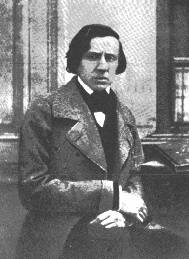Beethoven's Moonlight Sonata
Frederich Chopin's "Fantasie Impropmptu"
Franz Liszt's "Etude 3 La Campanella"
January 13, 2002 AT NOON Played on the Yamaha Clavinova
Performance to Last 27 Minutes!
Follow This Link to Beethoven's Third Symphony Page
Follow This Link to Beethoven's Fifth Symphony Page
Follow This Link To Liszt and Chopin Concert Given December 9, 2001
Beethoven, 1770-1827 See Beethoven Links above for More information
Franz Liszt, 1811-86 Click For More Information
Fredrich Chopin, 1810-1849 Click for More Information
Beethoven's Moonlight Sonata: Sixteen Minutes
The opening movement of the sonata, wrote a music critic named Rellstab, reminded him of the moonlight on Switzerland's Lake Lucerne. Though Beethoven called it "Sonata quasi una fantasia, op. 27, no. 2," and had probably never seen the moonlight dancing on Lake Lucerne, Rellstab's romantic image stuck, and it became known as the "Moonlight Sonata." When he wrote the Moonlight Sonata in 1801, Beethoven was coming to grips with the great personal tragedy that almost destroyed him, his increasing deafness. Soon after he finished the piece, he learned the worst, that he would soon live in total silence. Musically, Beethoven's intention with the piece was to break the tradition of clear divisions between a sonata's movements in order to create an unbroken musical flow.

Chopin's Fantasie Impromptu Op. 66 In C Sharp Minor: Five Minutes
Chopin was one of the first composers to incorporate the recently refined sustaining pedal of the piano. In his dreamy nocturnes, for example, the left hand introduces the smooth melody, making the pushing of the pedal almost mandatory to achieve the ethereal music which he creates. Along with Schubert, they are the grand masters of piano impromptus, short pieces that give the sense of improvisation. Chopin's most famous, the Fantasie-Impromptu, is one of great awe and delight to the listener, thus making Chopin the incontrovertible master of the piano.
“Fantasie Impromptu” is one of the most popular solo works in the
piano repertoire and there are numerous recordings available. Chopin composed
this work in 1834 when he was about 24 years old. By listening to several recordings,
you will find differences in interpretation such as tempo, rubato, pedaling,
etc. Each artist will have his or her own interpretation. Some play with much
bravura - in a heroic fashion. Others feel that Chopin should be played more
intimately based on remarks made by his contemporaries and piano students. It
was said that his forte was never very loud since he was frail and unable to
produce a big sound. But at the same time, Chopin paid a great deal of attention
to details such as phrasing, fingering and how it affected the quality of tone,
pedaling and articulation.
“Fantasie Impromptu” is written in ABA coda form. The A sections (Allegro
agitato) are written in C# minor and the B sections (Largo/Moderato cantabile)
are written in Db Major. Some scholars feel that there is a reflection of a
mini sonata form within the A section since the first modulation moves from
C# minor to E Major giving a hint of the second theme. Then there is a return
to the 1st theme in C# minor similar to a recapitulation. It is important to
point out that the genius of Chopin moved beyond his ability to compose beautiful
themes. He was a master of modifying the traditional classical form and created
more flexible designs for the demands of romantic music.
Liszt's Etude No. 3 La Campanella: Four Minutes
LA CAMPANELLA (“The Bell”) is from the set of Six Paganini Studies and is well known for its large leaps in the right hand as it quotes Paganini’s famous tune. To say Liszt's music is difficult to perform is an understatement. Today's chosen Liszt is considered one of the most technically difficult piano pieces ever written. It is included here to demonstrate the outstanding capability of our "Smith Memorial Clavinova".
Today's performance is entirely digital. It uses a technology called MIDI. First Lutheran has both a midi piano and a midi-hybrid pipe organ.